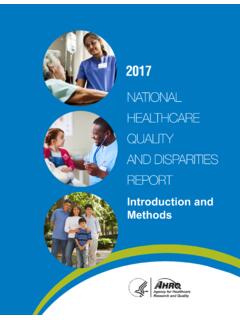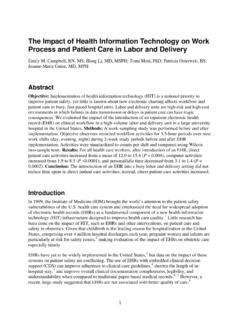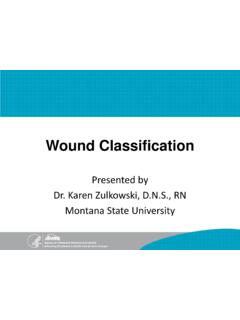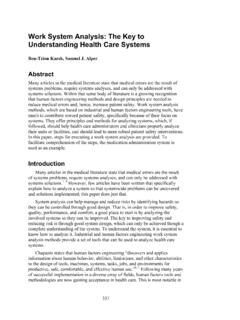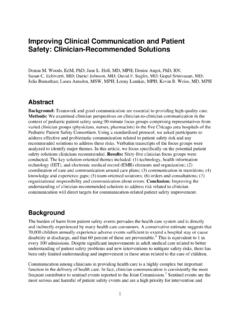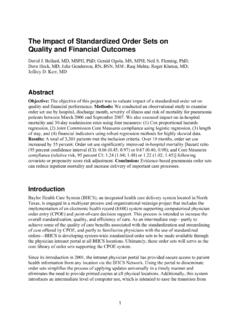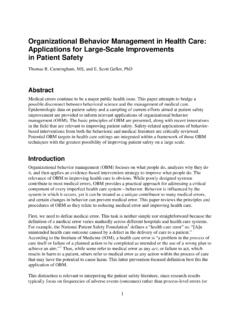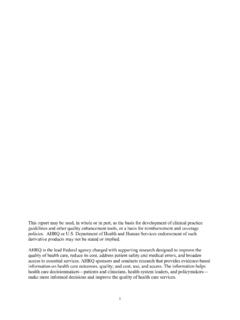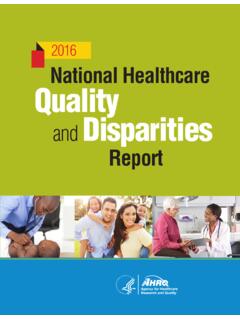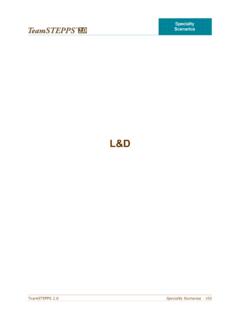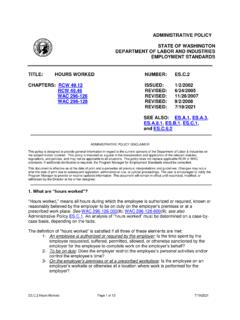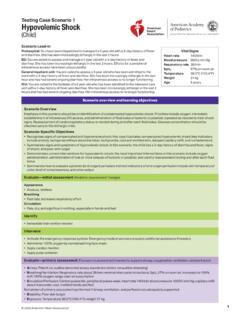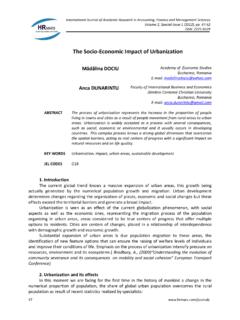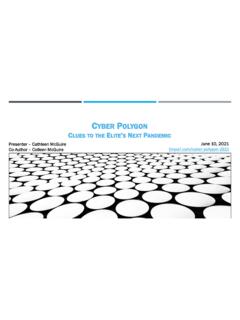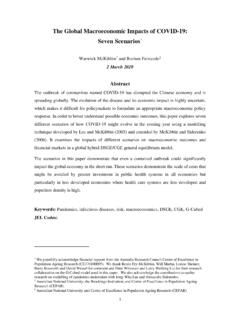Transcription of Labor and Delivery Unit Safety - Agency for Healthcare ...
1 AHRQ Safety Program for Perinatal Care Labor and Delivery Unit Safety AHRQ Publication No. 17-0 003-21-EF May 2017 SAY: The Labor and Delivery Unit Safety bundle provides information on the key Safety elements concerning four specific situations encountered in Labor and Delivery , and the importance of a comprehensive unit -based Safety approach to reduce the potential for maternal and neonatal harms. Slide 1 SAY: In this presentation, we will do the following: Describe the rationale for the use ofchecklists for reducing errors. Identify the key Safety elements for fourspecific situations encountered onlabor and Delivery (L&D) units. Identify ways the key Safety elementscan be customized for unit proceduresfor these four 2 SAY: This bundle in the AHRQ Safety Program for Perinatal Care, or SPPC, focuses on key Safety elements for four specific L&D situations: Safe cesarean section Shoulder dystocia Obstetric hemorrhage Umbilical cord prolapseThe training materials and tools for this bundle offer key Safety elements for these situations, with a focus on the use of a checklist.
2 These key Safety elements provide a starting point for each unit to consider as it establishes processes for ensuring safe care. These key Slide 3 Labor and Delivery Unit Safety AHRQ Safety Program for Perinatal Care L&D Unit Safety 2 Safety elements can also be adapted and applied to other perinatal situations that require high-reliability processes. SAY: Care Delivery varies greatly based on individual provider training, provider interpretation of evidence, their experience, and their preferences. Checklists help to facilitate Safety in high-complexity, high-risk, and high-reliability professions such as aviation, nuclear power plant operations, and naval submarine crews. Hospitals can adopt checklists to ensure the completion of critical procedures and processes within health care settings.
3 Cognitive psychology classifies tasks as either involving schematic behavior or attentional behavior. Schematic behavior includes tasks performed reflexively or on auto-pilot, whereas attentional behavior requires active planning or problem solving. The types of failures resulting from these behaviors are different. Errors associated with schematic tasks are labeled slips and occur because of lapses in concentration, distractions, or fatigue. Errors associated with failures of attentional behavior are labeled mistakes and often occur because of lack of experience or insufficient training. Most errors in health care are slips rather than mistakes. Checklists are cognitive aids that have numerous practical benefits, including reducing slips that occur due to lapses in concentration, distractions, fatigue, or lack of knowledge of evidence-based practices, because checklists decrease reliance on memory for tasks typically performed reflexively or on auto-pilot.
4 Checklists can also provide confidence that no step will be forgotten. Slide 4 Labor and Delivery Unit Safety AHRQ Safety Program for Perinatal Care L&D Unit Safety 3 SAY: Simply giving a generic checklist to staff, or posting one on a rapid response cart or kit or on a wall is unlikely to be effective at reducing errors. Checklist effectiveness for reducing errors can be enhanced when they are created or adapted to meet unit needs they are implemented within a culture that fosters teamwork and communication staff gain experience with them during in situ simulation practice Slide 5 SAY: Each of the four tools in this bundle of the SPPC includes the tool s purpose; its intended use by nurses, physicians, midwives and other L&D staff responsible for intrapartum care; key Safety elements presented within the framework of the Comprehensive Unit -based Safety Program, or CUSP; and a sample checklist or references or links to available checklists and other cognitive aids are provided for each situation.
5 The key Safety elements, sample checklists, and externally referenced checklists provide a starting point for each unit to consider as examples for establishing safe processes for L&D unit s afety. Units can customize, adapt, and tailor the specific clinical guidance or instructions on the checklist based on unit preferences, best practices, or emerging clinical evidence. The sample checklists provided are examples of how key Safety elements can be operationalized in a checklist; they are not provided as an endorsement of a specific clinical approach to management. Slide 6 Labor and Delivery Unit Safety AHRQ Safety Program for Perinatal Care L&D Unit Safety 4 SAY: As in the other customizable bundles available through the SPPC, the key Safety elements for L&D unit s afety are organized into six overarching principles of patient Safety derived from CUSP and the TeamSTEPPS t eamwork and communication system.
6 In this presentation, the six principles are presented by focusing first on situation-specific elements related to these three principles: Standardize When Possible Create Independent Checks Simulation This will be followed by the discussion of the other three principles that have a more general application across all of the four perinatal situations: Learn From Defects Teamwork Training Patient and Family Engagement Slide 7 SAY: First, we will highlight some of the key Safety elements from the tool for safe cesarean section. Slide 8 Labor and Delivery Unit Safety AHRQ Safety Program for Perinatal Care L&D Unit Safety 5 SAY: The first consideration of L&D unit s afety for safe cesarean section is to standardize when possible. This is a core principle from the CUSP Science of Safety module.
7 Standardizing procedures reduces and alleviates duplications of Labor and resources, reduces unwarranted variation among providers and staff, and offers a predictable approach that encourages a shared mental model across the unit. The key Safety elements focus on the use of a standard perioperative process that includes Preoperative briefing Timeout Sign out Studies have found that the use of a standardized perioperative process with these three components reduces surgical mortality and ,6 This perioperative process should be the standard approach used for ALL cesarean sections and should include Involving all physicians and staff members engaged in the surgery Knowing which member of the surgical team member is responsible for leading each step of the perioperative process Knowing the defined roles for each staff member involved in the surgery to reduce variability from case to case and create redundancy at critical steps Defining acceptable variations in the perioperative process for emergency cesarean sections Slide 9 Labor and Delivery Unit Safety AHRQ Safety Program for Perinatal Care L&D Unit Safety 6 SAY: The preoperative briefing reviews the plan ahead for patient care and the risks or concerns so that everyone has a shared mental model.
8 It includes reviewing patient information, procedure, indications, anticipated complications, risk, medical history, fetal status, and type of anesthesia. The obstetrician/surgeon typically leads the preoperative briefing. It allows him or her to flatten the hierarchy in the operating room, and encourage staff to speak up for Safety if they see something they don t think is right. Slide 10 SAY: The timeout assures Safety through a huddle or another checkpoint of redundancy for each team member to agree with the plan and maternal and fetal status. The timeout is typically led by the circulating nurse once all staff members are present in the operating room or OR. The signout and debrief provides a standard approach for wrapping up and debriefing the case by reviewing what has been done, the patient s current status, next steps, and what went well, what may have gone better or what might be done in the future, which is often a moment for process improvement.
9 The signout is also typically led by the circulating nurse but may be initiated by anyone on the team. Slide 11 Labor and Delivery Unit Safety AHRQ Safety Program for Perinatal Care L&D Unit Safety 7 SAY: The second consideration of L&D unit s afety for safe cesarean section is to create independent checks. This is also a core principle from the CUSP Science of Safety module. Independent checks help guarantee the patient receives the highest quality of care possible. Independent checks can include checklists, protocols, and briefings with other staff. L&D unit staff are able to focus on patient care and have confidence that untoward events (change in patient condition, errors in dosing, etc.) will be caught by a check or team alert when it occurs. The key Safety element is to use a checklist to guide the safe surgery perioperative process.
10 Studies have found that checklist tools can facilitate the three components of a safe perioperative Slide 12 SAY: A sample checklist, provided as an appendix to the tool, helps standardize the perioperative process for cesarean Use of a checklist may prevent unnecessary surgical complications and mortality. The checklist serves as a guide for teams by providing key Safety -related steps for a preoperative briefing, time out, and signo ut and debrief. Samples of the Safe Cesarean Checklist for Planned/Routine Cesarean Sections are provided in two formats: an at a glance format or a large print format. The specific checklist items can be customized based on unit preference. Slide 13 Labor and Delivery Unit Safety AHRQ Safety Program for Perinatal Care L&D Unit Safety 8 SAY: The next consideration of L&D unit s afety for safe cesarean section is simulation.
